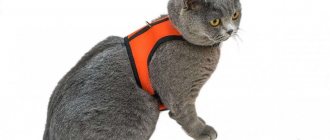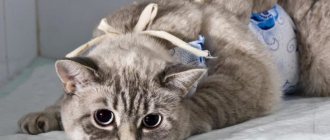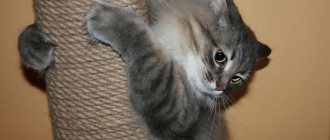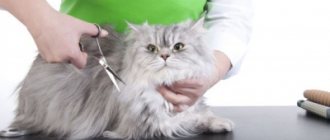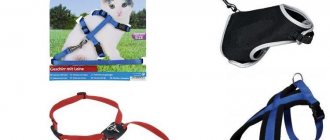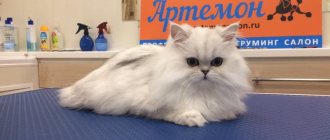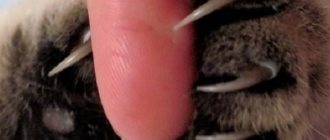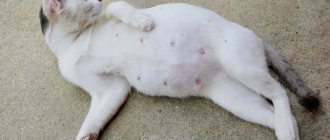Many people think that pet clothing is only for dogs. This is fundamentally not true, because lately more and more things have been appearing for cats and other pets. Most of the clothes are intended for walking short-haired cats and Sphynx cats. They freeze faster than others and need warmth. One of the necessary types of clothing for cats is a blanket after sterilization. This material will tell you how to sew a blanket for a cat after sterilization - the pattern and the sewing process itself.
How to take measurements from a cat
The main measurements to take are:
- neck girth. This is the circumference of the neck at its thickest and widest point. This is usually its base. To ensure an even measurement, it is necessary to place the animal on a flat surface;
- back length. The measurement is taken from the base of the neck to the beginning (root) of the ponytail. A centimeter placed along the spine is best suited for this;
- sternum girth. This measurement is taken around the widest part of the chest - under the front legs.
You might be interested in Interesting and simple patterns of overalls for dogs
These measurements are enough for most products, but sometimes additional data is needed. For example, the distance between the paws.
Cat measurements
Dressing up
The functionality and effectiveness of using a bandage for a cat during its postoperative period after sterilization depends not only on the correctness of its cut and manufacture. After surgery, the bandage must be tied correctly and carefully. If the fasteners or ties of the bandage are pulled too tightly, it will be too tight, and this will have a bad effect on the healing processes of stitches and wounds. A very loose tie is also ineffective; it will move, rubbing the seam on the animal, or the cat will pull it off altogether, and also damage the seams.
When dressing correctly, you need to unfold the bandage, straightening all the ties. Then the cat carefully lies down on it and the ties are secured in front near the head and front paws. After this, the back ties are tied in pairs above the paws and they are bandaged in the pelvic area. With different cuts of blankets, there may be a different order of dressing. The main thing after putting on the bandage is to make sure it is properly fixed. To do this, you need to let the cat move around the apartment. If she feels comfortable, moves around freely and does not try to tear off the bandage, then he is wearing it correctly.
However, most cats feel uncomfortable wearing a bandage. They try to get rid of it, gnaw and tear it with their teeth and claws. Therefore, a properly selected fabric for a bandage, especially its upper part, should be relatively durable. If the cat nevertheless takes off the blanket, then first of all you need to inspect the seam and, if necessary, contact a veterinarian. If everything is fine with the seam, you need to carefully put the bandage back on so that it fits tighter.
Be more kind and gentle to your pets during this difficult period for them, pay them more attention and then they will forget about the bandage.
How to make it from scrap materials?
If you suddenly need a blanket for a cat, but there is no way to get to a pet store and the animal owner has zero sewing skills, there will still be a way out. In any home you will find things from which you can build a quite decent bandage.
Read also: How to get a water arrow in Terraria -
The easiest option is to make a post-operative bandage from tights or leggings. It is enough to select a part of the product that is suitable in width and cut a piece of the required length. After this, slits are made for the paws, and the blanket is put on the cat.
The advantages of this method are undoubted:
- the bandage is made very quickly, the whole process takes no more than 5 minutes;
- no sewing skills or pattern creation required;
- the elastic, soft cover is easily pulled over the animal and does not bother him too much;
- From one tights you can make several blankets.
There are also disadvantages:
- stretch tights (leggings) are not secured to the body in any way, so they constantly curl up and slide down;
- the material of the product is unlikely to withstand the power of cat claws, which means it will become unusable after a couple of active scratches;
- For representatives of small breeds, a blanket made in this way may be too loose and not tightly enough to fit the damaged area.
Do it yourself
The higher the density of the material, the more durable the bandage will be. And, of course, before using tights, they must be washed thoroughly.
A similar method is to use a sock. The front part of the product is cut off and, stepping back about 3 cm from the elastic, holes are cut out for the paws. Socks should be of the appropriate size and good quality, made of thick, elastic fabric. Cheap socks will quickly stretch or begin to fade.
Another option is suitable for those who still have children's clothing for the little ones. An elastic blouse or vest after a little modernization (cut off the excess) may well suit your pet. The advantages of this solution:
- children's clothing is made from eco-friendly, soft fabrics;
- The blouse already has ties, buttons or Velcro.
The downside may be the inconvenience of human clothing for a cat, as well as the difficulty in choosing the appropriate size.
Kinds
Do not think that a blanket is the only type of medical bandage. In fact, there are several varieties of it. Different types of blankets differ in their features and design. Let's get to know them better.
Warm
Cats, which are representatives of hairless breeds, often freeze when there are cold seasons outside the window. This not only causes significant discomfort for pets, but can also lead to the development of colds. In such circumstances, a special warm blanket would be an excellent solution. Most often, caring owners of Sphynxes and Cornish Rexes turn to such things. These types of blankets look like simple sleeveless vests.
The best and most comfortable blankets are warm blankets made from soft fabric with large pile. Such things effectively protect hairless or short-haired cats from low temperatures and cold gusts of wind. Even during a walk, your pet will be warm and comfortable in a cozy blanket.
Separately, it is worth highlighting the knitted woolen blankets that fit the body well. These specimens are especially warm and have an excellent warming effect. They are very comfortable for cats and kittens.
Homemade
Among cats and kittens, there are a lot of individuals that suffer from allergic shedding. In this case, the owners constantly have to vacuum the furniture in the house, but this is only a temporary measure - soon all surfaces are again covered with hairs that have fallen from the pet’s body.
In such situations, many people look at hairless cats, mistakenly believing that the lack of hair makes them completely problem-free. Such individuals have another common ailment - profuse sweating. Because of this, stains may remain on upholstered furniture, which can be very difficult to remove completely.
In the above situations, homemade blankets can be a real salvation. These products easily and simply absorb secretions from the body of hairless cats. Wool loss with such blankets is also noticeably limited. This is why homemade products are so popular and in demand today. However, most home models of blankets still fall into the category of interesting animal wardrobe items.
Raincoats
When walking with an animal outside in cloudy weather, it is worth keeping a small raincoat for your pet. Such models, as a rule, have a hood and are fastened under the neck and belly of the cat. Raincoats are made from special water-repellent fabrics, such as nylon or vinyl chloride. Polyamide fiber of rich colors is in no way inferior to transparent film in its properties and characteristics. If a rainstorm suddenly starts, the animal in such a cape will only wet its paws.
Postoperative
Initially, after various operations, cats were given a special Elizabethan collar. It was a large cone that was fixed on the animal’s neck and did not allow it to reach the wound. Of course, such things were very disturbing for the pets and caused unnecessary stress. In addition, pets wearing such collars could not wash their faces properly, and eating in them was problematic - the edges constantly hit the bowl, and the food did not always get into the animal’s mouth. Moving around the house in such a collar was also problematic, it threatened injury: the cat could get caught on furniture, doors or doorframes.
It is not surprising that the blanket has become a wonderful replacement for this outdated device. In such a thing with a zipper or Velcro, the pet can move freely around the house, eat normally, and even play. Although protective mantles may slightly restrict the movements of cats and cats, they still will not prevent pets from leading a normal lifestyle. Thanks to this, the recovery process is much easier and faster.
Dress for the sphinx
Using a simple pattern, you can make a beautiful dress for your hairless Sphynx cat. The most remarkable thing is that a dress of this kind can be made from just two pieces. First of all, the main part is made, and then the sundress, which is sewn to the base.
For your information! All this takes very little time, but looks very attractive. Do-it-yourself clothes for the sphinx, the patterns of which are presented in the picture below, can be made in a matter of hours.
Knitted suit on a Canadian cat
Cape options
If a horse needs a cape, then the lightest material for sewing should be used. Most often they are used during training or in the summer, when the animal is taken for a walk. Thanks to this option, the horse’s skin practically does not get dirty either in the levadas or in the stable. Can also be used on a hot day.
Today, horse blankets are being improved. All the options already listed are just a small part of what is currently available. There are also training blankets that are suitable for horses with thin skin. They will retain heat and absorb excess sweat.
We suggest you read: How to distinguish a male from a female betta fish
Drying blanket
Rain capes protect from precipitation; they are worn over the saddle. A blanket with fluorescent elements is ideal if the walking route is located near the highway.
How to put on and take off?
If the bandage is put on immediately after the operation, when the animal has not yet recovered from anesthesia, then this does not cause any difficulties. But when it is necessary, for example, to change a soiled bandage, the animal may show dissatisfaction and try to interfere with the owner. Here you will need an assistant who will carefully hold the pet.
How to wear
In both cases, you need to know how to properly tie a blanket for a cat. Most often, a purchased product or pattern is provided with marks on the position of the head, paws and tail, as well as numbering of the ties.
For manipulation, the cat is either placed on its side or placed over a blanket. A standard blanket has seven pairs of ties, they are numbered starting from the front ones. They are tied in the following order:
- the first pair is around the neck;
- the second and third - together in the area of the shoulder blades;
- the fourth - approximately in the middle of the body;
- the fifth encircles the lower back;
- the sixth and seventh cross, fixing the hips and tail.
Do not tighten the tapes too much. The bandage should fit snugly around the cat's body, without sagging, but should not squeeze, preventing it from moving normally. If you can stick a finger between the bandage and the body, everything is done correctly.
The ties should not be too long so as not to cling to all the objects that the pet passes by. The back of the body should be open so that the animal can freely go to the toilet without soiling or wetting the bandage.
If it is necessary to treat the wound, it is not necessary to remove the entire blanket. It is enough to untie only the back ribbons and unscrew the edge, freeing up the damaged area.
Buy or sew?
You can buy a blanket at a specialized pet store. This is an option when a bandage is prescribed after a major operation, where maximum sterility and quality are required. The advantage of a purchased product: variety of colors, sizes, manufacturers.
The products are made from dense, lint-free non-woven materials. This way they don’t leave hairs and don’t form pellets after lying on the sofa. At the same time, they are easily adjusted and can be cut to fit the size of your pet.
The fabric fibers have a structure that quickly absorbs liquid. This is a big plus for the animal’s postoperative body when the wound is tightly covered with material and is not in danger of getting wet. Another advantage of a medical bandage is that it is not subject to rupture. They have a long service life, tolerate washing well and do not have harmful components that would have an aggressive effect on the pet’s skin.
However, if the owner is not ready to spend a lot of money, and the bandage was not a prerequisite for the doctor, you can make a blanket for the injured cat with your own hands.
How to put on a blanket correctly?
A bandage with ties is the best option for a post-op pet. First, ties are harder to remove. Secondly, a high-quality blanket fits securely and does not move around the body, irritating the cat. However, it is more difficult to use. So that even an inexperienced owner can figure it out, below are photo instructions on how to properly put on this design.
How to properly put a blanket on a cat
To begin, spread the material and place the cat over it (you can put the pet on its side, then part of the product should go under the body). Next, gradually fix the ties on the body:
- Ribbons numbered 1 are tied at the base of the neck.
- Ribbons 3 and 2 are tied into the common fastener; the recesses for the front paws should not interfere with the pet’s movement.
- 4 ties are fixed at the top, on the back.
- Next we tie 6, clasping the left thigh, and fixing 7 on the right.
- After the last step, from four ribbons 6 and 7 you should get two. We tie them under the base of the tail.
As a result, the cat bandage should fit snugly to the chest and stomach, and the tapes should secure everything from the neck to the tail. At the same time, it should not interfere with blood circulation, constrain, press, or rub the pet’s skin. Do not try to tighten the ties too much.
Veterinarian advice
The use of a postoperative bandage is associated with certain difficulties. To simplify this task, specialized experts recommend the following:
- When tying ribbons on a blanket, try to keep their ends as short as possible, so that the animal does not get caught or suffocate.
- In the first days of the rehabilitation period, you must constantly be with your pet, as he will try to remove the “cover”.
- If the wound is bleeding, place a sanitary pad under the bandage.
- When your cat wants to go to the toilet, do not completely remove the blanket. Just untie the last two ribbons.
That, in fact, is all you need to know about postoperative bandages. However, finally, it is worth noting that sterilization is a great emotional shock for the animal, so you must be very careful and patient with it. Only with proper care will your four-legged friend be able to recover quickly.
DIY sewing
Although blankets can be quickly made from scrap materials, sometimes problems arise. They are difficult to fix on the cat and it is almost impossible to choose products of the appropriate size. The quality of materials also does not always meet expectations. If it is not possible to buy a suitable option, then it is better to sew the model yourself.
First you need to take all measurements to create a pattern.:
- body length excluding tail;
- volume of the animal's chest;
- the distance between the hind and forelimbs.
The pattern resembles two connected rectangles with holes for the paws - a large one that will cover the body, and a small one that is attached at the base of the tail. Ribbons are sewn to all edges of the product; there should be at least 8 of them in total, but it is better to increase this number. When transferring the contour of the model from the pattern to the fabric, allowances of 1 cm wide are added on each side. If Velcro is used for fixation, then increase the figure to 5 cm.
After this, you need to choose the appropriate fabric. It should be soft and elastic, but not subject to strong stretching. Fraying textiles are not suitable as their fibers will get into open wounds. To check, a small piece of material is tied into a knot. A high-quality product will not tear, threads will not fly off. Dyed fabric is also not suitable as it will fade. A pattern is cut out of the material and the edges are hemmed. Then Velcro or ribbons are attached.
The version with Velcro is more convenient to use; with their help it is easy to remove and put on the blanket. The compactness of the fasteners allows the cat to move freely, they will not restrict her. The sticky sides of the fastener quickly become covered with dirt and wear out; they will have to be re-stitched periodically. Particularly active and inquisitive cats can learn to unfasten them.
It is easier to sew ribbons onto the blanket, and they are made from the same fabric as the bandage itself. If you tie them tightly, then even with the active behavior of the animal they will remain motionless. But bows and knots will cling to surrounding objects, and if the knot is tightened too much, you will have to cut the part and sew on a new one.
Product functions
The need for the cat to wear a special blanket or bandage during the postoperative period is determined by the doctor who performed the operation. Sometimes the specialist is able to place stitches in such a way that the cat does not need additional support. Therefore, wearing a bandage is not prescribed.
In most cases, the presence of a blanket is necessary, since additional protection of the operated area from dirt and pathogens is required. Contact of any contaminants or pathogens on unhealed wounds can cause an inflammatory process, which can lead to various complications. The blanket will close the seams from the external environment, thereby promoting faster healing of wounds.
This bandage prevents the pet from licking the operated area. The tongue of these furry animals is very rough. Therefore, he is able to damage the stitches, opening the wound. Cat saliva is considered a natural antiseptic. But it contains a large number of bacteria, some of which can cause inflammation. The blanket is an excellent protection against these two risk factors.
Wearing also limits the animal's mobility, thereby minimizing the possibility of seams coming apart due to the cat's activity. During the postoperative period, ichor or blood may leak from a still fresh suture. Such discharge not only stains your pet's fur, but can also remain on furniture or clothing. In the summer, such secretions attract blood-sucking insects that can carry pathogens. Wearing a special bandage helps prevent contamination of fur and objects, as well as protect wounds from contact with insects.
A homemade or purchased blanket is excellent protection for sutures, and also makes caring for a pet who has undergone surgery much easier. Only in rare cases, when a doctor uses a special suturing technique, will wearing a bandage be undesirable.
Something else interesting: Are there cats that don't shed?
How to make a blanket with your own hands
If you decide to sew a post-operative bandage for an adult cat yourself, then it is better to use your own knitted items for this. The animal knows the smell of the owner and wearing such a product will cause less protest than with a factory bandage. The summer dress your daughter has outgrown is also suitable for sewing a large headband.
To make a protective blanket, use chintz or printed calico, which are sufficiently breathable and at the same time soft and dense. It is advisable that the new fabric be washed in advance, otherwise it will shrink during use. The blanket is sewn from two layers of light-colored material.
We will need:
- pins;
- pencil;
- ruler;
- scissors;
- threads;
- needle;
- textile;
- tapes.
To take measurements from your furry pet, use a tailor's centimeter. It is also suitable for marking blankets if the length of the ruler is shorter than 40 cm.
Manufacturing stages
Lay out all the parts to work on the table. The model will have 14 ribbons, so you will have to use 3.5 meters of ribbon. It can be replaced with strips of any durable textile or synthetic material.
A sock blanket - for this you will need a clean sock or knee socks (it must match the length of your pet’s body, directly from the shoulder blades to the pelvis).
Sock for making a blanket
Cutting in the sock
For the pelvic areas, cut out a small indentation. It will be held on the neck and groin line of the animal.
Slit along the toe
This is not the most suitable option; if the cat really wants, she will be able to remove the blanket and even bend over to lick the wound.
A do-it-yourself blanket for a cat, after sterilization, made from tights is a more reliable option (in terms of fixation). All work will have to be done in the same way as with cutting out holes from socks and knee socks. But, additionally, you will need to make a collar in the form of a T-shirt and put the cat’s head through it, and the lower part will be secured with a cord or elastic band along the animal’s groin line.
Need to:
- Cotton fabric (chintz or calico);
- Linen elastic;
- Binding for edging.
How to sew a blanket for a cat after sterilization? – to make a product you need to make a pattern diagram and perform the following steps:
- Take cotton fabric, a measuring tape and a pattern sheet;
- The sheet on which the blanket pattern for the cat will be patterned after sterilization will need to be divided vertically in half;
- Using preliminary measurements, we transfer them to the fabric using a fabric chalk;
Measurements for a medium size blanket
- When sewing, do not forget about the presence of ties;
- If your pet is very active, you can secure the blanket with Velcro (then the ends are not taken into account in the pattern);
- Check everything again and start cutting out the blanket;
- Trim the ties on both sides;
- At the end of the stage, try the product on an animal to make sure everything is done correctly.
Nuances
- To all measurements, add an allowance of 0.5 - 1 cm on both sides;
- Don’t throw away the pattern right away; it’s better to make another blanket so you can change it for your cat every day.
As you can see, the question is: How to make a blanket for a cat after sterilization? - does not present any difficulties in manufacturing, you can easily start doing the work right now.
After you have sewn a bandage for a cat after sterilization, it must be washed and rinsed without using household chemicals. Be sure to iron it using an iron. Only after this can you put a blanket on the animal.
Ties, Velcro or lacing, should be located so that the cat does not pay attention to them
Terms of use
The animal's sutures must be periodically washed and treated during the postoperative period. In the process of performing such actions, the blanket does not need to be completely removed. Only the bottom pair of ribbons is untied. The product must adhere firmly to the cat.
If the bandage is dirty or has strong discharge, it is removed and replaced with a new one. Blankets should be changed regularly to minimize the risk of rotting and wound infection.
The product is completely removed only at the discretion of the veterinarian. If the blanket was made correctly and used correctly, it will ensure a quick recovery for the cat.
What to do if your cat takes off his blanket
Regardless of the type of blanket used, owners of operated animals often face the same misfortune: their pet takes off the blanket. It is unlikely that it will be possible to constantly monitor the animal, and it will be very tiring for the owner. Therefore, it is better to go the other way.
Physical limitation of mobility
An option ideal for night time. The cat must be placed in a portable cage, basket or box that limits the pet's mobility. Having lost the ability to constantly spin and run, she is unlikely to be able to remove the blanket.
Surgical collar
This collar, also called the “Elizabethan” collar, resembles a funnel worn around a cat’s neck. This design reliably prevents all “rash” actions of the animal, preventing the removal of the bandage.
However, this method is not very suitable for young cats, as they can be very nimble.
Medical immobilization
If the cat is overly active, the veterinarian may prescribe mild sedatives. They, having a calming effect, prevent tightening of the postoperative bandage.
Despite all the methods described above, the main role in maintaining the blanket on the animal’s body belongs to the cat’s owner. You need to talk to your pet more often, pet her and calm her down. The faster the cat gets used to the blanket, the faster it will stop trying to remove it.
Dressing rules
Place the blanket on the pet, having first laid it on its side. Then they bring its edges together and tie the ribbons. The product should not be fixed too tightly. A properly worn bandage should fit snugly to the body and not sag or dangle. Strongly tightened ropes impair blood circulation at the dressing site, which increases the healing time of tissues. For greater reliability, the ribbons are secured to the paws and neck; their edges should be short.
They remove the blanket in the same way as they put it on. The cat is placed on its side, the fastenings are untied and the product is removed. Every day you need to allow the animal to walk for at least half an hour without a bandage, this will allow the seam to dry out faster. They finally get rid of the dressing material only on the day when the veterinarian allows it. This usually happens 8-9 days after surgery.
All owners of sterilized cats are faced with the fact that their pets take off their blankets. It will not be possible to constantly monitor the animal, so they resort to more stringent measures. At night, you can limit your cat's movements by placing her in a cramped crate or portable basket. She will not have the opportunity to run and twirl, so the blanket will remain in place.
Additionally, a surgical collar is put on the animal . Thanks to him, the cat will not be able to pull off the bandage with its teeth. If there is increased activity, the veterinarian may prescribe sedatives. They calm the pet and do not allow it to actively move.
But still, the main responsibility for the condition of the cat after sterilization lies with the owner. He needs to constantly stroke the animal and talk to it. This way, your pet will quickly get used to the blanket and stop trying to remove it.
